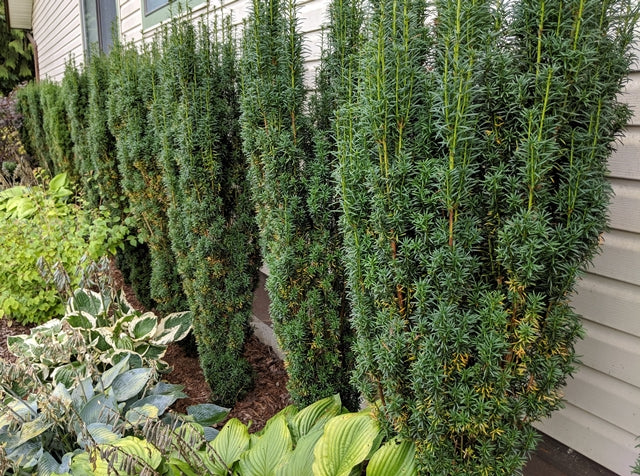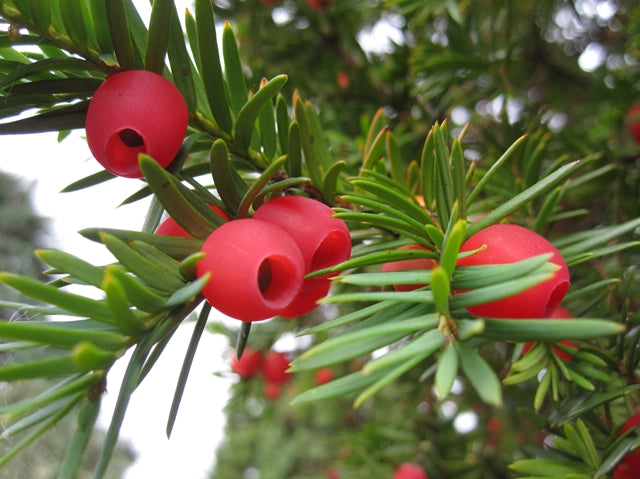by Ken Lain, the mountain gardener

Yews, Taxus, plants are conifers, so they produce cones, along with red berries. They feature evergreen needles in two primary forms, a spreading shrub or a tall columnar tree. They have a relatively fast growth rate that slows as the plant matures. Britain and elsewhere in Europe use the evergreen branches in holiday decorating. Sprigs are cut to be used like holly in natural Christmas decor.
Botanical Name Taxus
Common Name Yew bush, yew tree, yew shrub
Plant Type Evergreen Conifer
Mature Size 4 to 15′ feet tall, depending on the variety
Sun Exposure -4 hours of sun to full shade
Soil Type Loamy, medium moisture, well-draining
Soil pH 6 to 8
Bloom Time Nonflowering
Hardiness Zones 2 to 10
Native Areas Europe, Africa, Asia
How to Grow Yew
Yews often serve as foundation plantings around the home. They are also common in hedges and topiaries. Preferring the shader spaced in the garden, they brighten the north side of tall walls and stucco homes. The low spreading varieties are more suitable for foundation plants or short decorative hedges.
Excellent soil drainage is vital for growing yews. These plants can be susceptible to root rot and other fungal infections, often due to soggy soil conditions. Overall the plants are low-maintenance.
Light
Yew plants can be grown in partial shade, even full shade. Preferring the shader spaced in the mountain garden, they brighten the north side of tall walls and stucco homes. Yew grows well under the canopy of other trees and among pine forests.
Soil
Yew can tolerate several soil types, as long as the soil has good drainage. Poorly drained soil can result in root rot. Yew tends to thrive in rich loamy soil with a soil pH of 6 to 8.
Water
Along with adequate drainage, Yews grow best in moderately moist soil. Irrigate young plants twice a week to maintain soil moisture. Once established, it becomes more tolerant of dry conditions.
Temperature and Humidity
Yews grow in all cold climate conditions in zones 2-8. In scorching summer weather, the shrubs will appreciate more water and shade. Humidity typically isn’t a problem for yews, though they can struggle in scorching, humid summer weather.
Fertilizer
Feed with Watters 7-4-4 All Purpose Food 3 times per year (March, July, and October) for denser foliage and deeper green color.

Toxicity of Yew
All parts of yew plants except for the berry’s flesh are poisonous. Even the berries are inedible because of the toxic seed developed inside each berry. Some signs of poisoning in both people and animals include vomiting, difficulty breathing, irregular heart rate, blood pressure, and dilated pupils. The good news is animals find yews equally toxic and leave this plant alone, including deer, elk, javelina, and rabbits.
Pruning
Overgrown yews can be rejuvenated with good pruning and shaped to your preference. It’s not essential to prune annually, but it can be helpful to promote lush growth. The best time to prune is late winter to early spring before the new foliage appears in March. Start by removing any dead, damaged, or diseased branches. Use hand pruners or branch loppers to cut stems back to where they join other branches.
Varieties of Yew
Many types of Yew are popular for landscape use, including:
- Taxus baccata ‘Fastigiata’: This plant has a columnar shape at around 15′ feet tall X 4′ feet wide and is often used for privacy hedges.
- Taxus baccata ‘Repandens’: This variety grows roughly 2′ feet tall X 12′ feet wide and is used for foundation plantings or short hedges.
- Taxus canadensis: Canadian Yew, this species has a spreading growth habit and reaches around 4′ feet tall X 7′ feet wide.
- Taxus cuspidata ‘Monloo’: This variety grows to 3′ feet tall X 8′ feet wide and is used for foundation plantings or short hedges.
- Taxus media ‘Hicksii’: This plant also has a columnar shape at 12′ feet tall X 6′ feet wide and is used for privacy hedges.
How to Plant a Yew Bush
Companion Plants with Evergreen Yew
Arizona Cypress
Austrian Pine
Mint Julip Juniper
Red Cluster berry Cotoneaster
Boxwood

